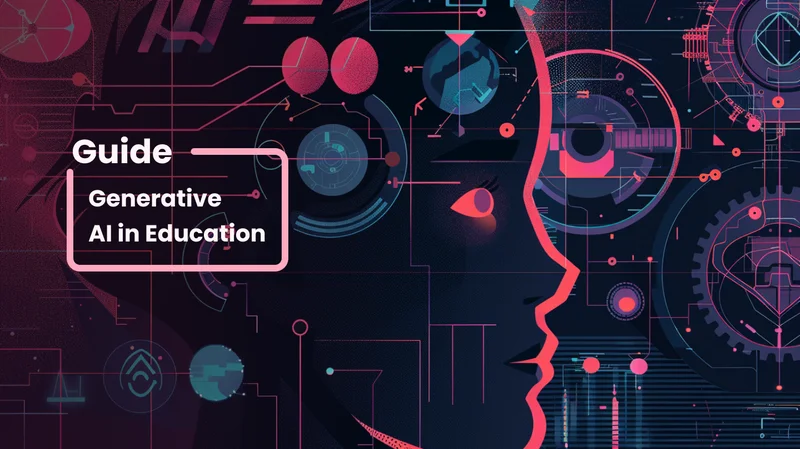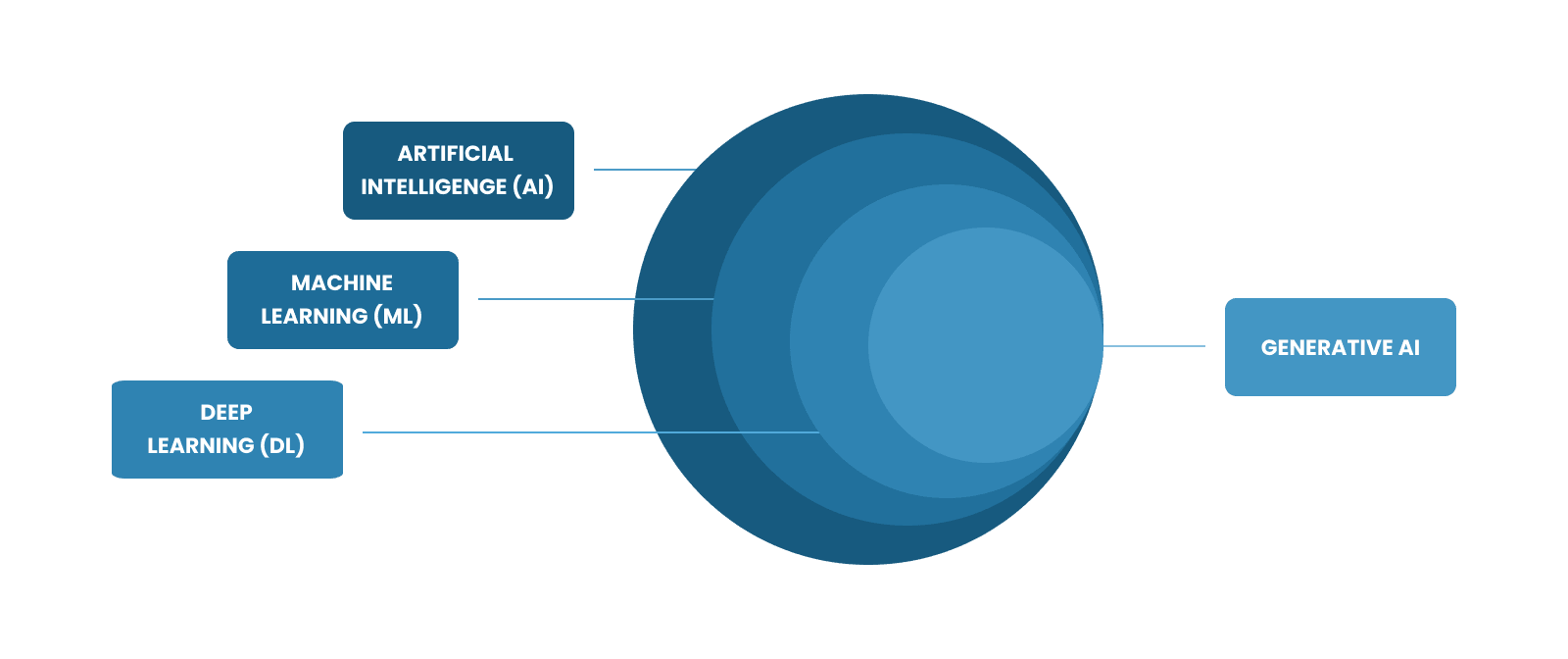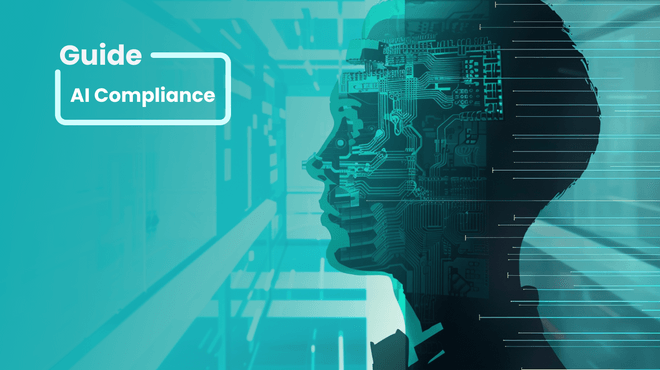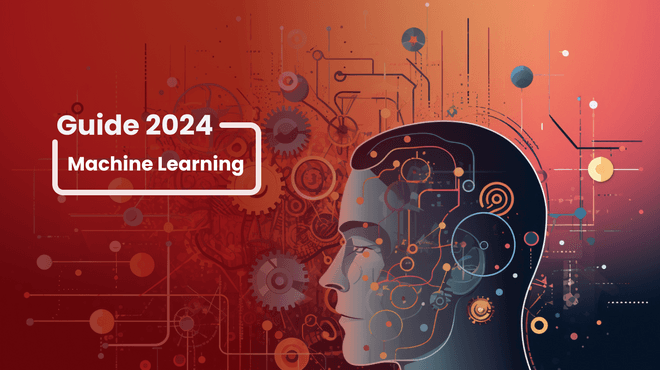Generative AI in education. Everything you need to know

This article explains generative AI and its usage while custom education software development. The first part is a crash course in generative AI, machine learning, and deep learning. The second part talks about how to apply generative AI in education. Finally, we talk about the challenges in Gen AI.
The article will help you talk to your colleagues about generative AI and make informed decisions. Let’s get started.
What Is Generative AI? Let’s Learn the Basics First
Generative AI can produce new content like text, audio, images, or a mix of that. But you probably know that already.
To get deeper, we need to start with the basics. When you understand the core concepts, it is much easier to grasp the big picture without getting boxed up. A combination of Generative AI with other AI solutions can bring amazing results.
AI is like an onion, with many layers inside – Gen AI is in the very middle. Let’s peel that onion from the top.
Artificial Intelligence (AI) is a technology that helps machines mimic human intelligence. AI systems can see, learn, solve problems, or make decisions.
Machine Learning (ML) is a subset of AI that relies on adaptive learning. Machine learning behavior is not explicitly programmed, the algorithms learn autonomously. That’s why such models can get better over time and not stay rigid.
By contrast, non-ML AI models are rigid and rule-based. Most modern AI systems apply at least some elements of machine learning. That’s why the terms are often used interchangeably. But you can still find non-ML AI models in fields like robotics, speech, or image recognition.
Looking for AI Consultant?
With our vast expertise in AI and EdTech we could help to understand how to get maximum for your elearning business with the trendy artificial intelligence technologies.
Deep learning (DL) is a subset of ML that uses neural networks. A neural network is a set of different formulas that mimic how our brains work.
To train the model, developers upload real-world input and output data. The AI will try to find connections between input and output. They are called the hidden layers. At first, the hidden layers are random and can be incorrect. But after each step of training, the connections become more accurate.
Let’s say, you want to create a neural network that predicts exam grades. First, you need a random hypothesis. Does perfect attendance equal perfect test scores? The model tests it and compares the results to real world data. If the results were not correct, the neural network will work the math magic to come up with better predictors of test scores. This process will take many iterations, until the developers are satisfied with the accuracy.
The more diverse your input data, the more accurate the results. To estimate exam scores, you may need to collect more than just attendance. It could be student grade history or time spent on finishing homework.
Generative AI. Finally, Gen AIis a subset of Deep Learning. Deep Learning can be of 2 types: discriminative and generative.
Generative AI generates new data, while Discriminative DL is used to classify and predict data.
Here’s how to tell if you have generative AI or not. It is Gen AI when the output is content like text, audio, image, video, or any combination of those. It’s not generative if the output is mathematical: a probability, a number, or a classification (is a student cheating or not?).

What Is Generative AI
Want to learn more? Read our in-depth Machine Learning Guide.
Different Types of Generative AI Content
Generative AI goes beyond ChatGPT and Midjourney. Various models can take different inputs to produce a wide range of outputs. But let’s focus on the most popular input types: text and images.
Image Input
- Image-to-text can add captions to images. This is how your phone can sort out your photos and tell your friends apart from your pets, or your documents. Thanks to these models, you can search images or ask questions about them.
- Image-to-image models can improve image resolution. If you have a blurry or damaged picture, such models can fix it.
- Image-to-video models can animate your pictures.
Text Input
- Text-to-text models can translate or summarize texts, correct your grammatical mistakes, or answer questions. LLMs like ChatGPT combine all the functions and generate all sorts of text.
- Text-to-image models generate images and videos from your text prompts.
- Text-to-audio can simulate sounds from a written text. There are even text-to-song models that generate music with a certain mood or specific chords.
Combinations
Several Gen AI, mixed. There are plenty of Gen AI types. Once you start combining the algorithms, the list becomes exponentially longer.
For example, let’s take a voice assistant that can generate a video lecture. First, it needs to converse your voice prompt to text. Then, another algorithm will generate a lesson structure based on your request. A third model creates illustrations and puts them together in a video. Finally, a text-to-speech algorithm will read the lesson. That’s 4 different models put together.
Gen AI + other AI. Once you start combining generative AI with other AI solutions, the long list becomes endless.
Back to our lecture generation. What if we add a model that analyzes the performance of every student and adjust the lecture accordingly? To struggling students, the model will thoroughly explain the basics with more examples. To outliers, the model will get deeper and explain advanced material.
Learn More about Our AI in Education Expertise
Harness the power of our AI expertise to gain a competitive edge, streamline operations, and deliver an exceptional educational experience.
How to Apply Generative AI in Education
Teacher shortage is real all around the world. By 2030, Europe and North America will need to hire a third of teacher numbers from 2022. Subsaharan Africa with its booming population will need to almost triple the teacher numbers. Here’s how generative AI can save the day.
24/7 tutors. With Gen AI, personalized learning won’t be for the privileged few. Millions of students will be able to study customized materials and ask questions to their AI tutor.
Faster lesson creation. Overworked teachers will spend less time creating lesson plans, rubrics, and assessments. AI can generate a draft in a second, while still keeping curriculum requirements in mind.
Internationalization. Generative AI can not only translate content but also adapt it to fit the local context, replacing cultural references and idioms.
Better accessibility. AI can adjust content to specifically tailor a student’s disability. For example, visually impaired learners will benefit from text-to-speech and image recognition. While learners with hearing disabilities will take advantage of speech-to-text.
Adaptive summaries. Many students no longer take notes in online learning. Automatic summaries can help. To make sure that students still pay attention in class and don’t just rely on summaries, AI solutions can add engagement recognition. If students are engaged, they get personalized summaries. If not, they’ll get a basic recap.
Content creation. AI can generate additional learning materials in seconds. This can be simple content like flashcards and discussion questions. But it can also be 3D models, illustrations, or animations.
Adaptive learning paths. We know that each student is unique. Some learn quickly, some need time to progress. Gen AI can adapt to each student’s progress, so no learner is bored or feels left behind.
Adaptive testing. The best tests are unique to every learner, not standardized. When a platform knows the student’s track record, it can maintain the right level of challenge. Tests can specifically target the weakest points or mix in easier questions to reinforce the memory.
Not just Gen AI. AI is much more than generating content. Read our AI in e-learning guide to learn more about advanced analytics, improved learning paths, and more.
Best Gen AI Solutions Are Personalized
Without personalized data, generational AI can only go so far. Best solutions don’t just generate content. They generate specific content for specific learners. Thankfully, there’s a standard protocol designed for tracking user experiences.
xAPI (Tin Can) is the industry-standard protocol for tracking learning experiences. If you want to analyze learner actions, you’ll need xAPI. With it, you can track any user actions:
- Which parts of a lecture do learners skip?
- What grades do they get?
- On which quiz questions do students spend the most time?
- What actions and decisions do learners make in games?
The protocol is multi-platform, supporting mobile, desktop, web, and even wearable devices. This means that xAPI can collect data from all learning software.
If you want to learn more, read our in-depth Blog Post about xAPI.
How to Integrate AI With School’s Software?
Let’s say you have an AI tool. How do you get it to users?
K-12 EdTech companies should be the first to worry about LMS integrations. Schools already have a digital ecosystem, and they don’t want kids to remember more passwords. So your AI tool must fit in with the school LMS. You can develop LMS with great features, but then discover that school doesn’t support it.
How to fix the issue? Make sure, your software complies with industry protocols: OneRoster and LTI.
OneRoster is a set of standard rules for organizing student data. Thanks to OneRoster, different LMS and SIS can synchronize.
LTI is a standard for synchronizing LMS with all other learning software, including your AI tool.
What’s the Next Step?
Read our article on machine learning for deeper tech understanding. Read about OneRoster and LTI if you’re in K-12 and higher education. Read about xAPI if you want to collect student experience data.
Need help? Book a free consultation with our Generative AI experts. We build AI solutions for corporate education, curriculum publishers, and eLearning startups. On the call, we’ll suggest how Gen AI can step up your company. We’ll also answer any questions you may have.



